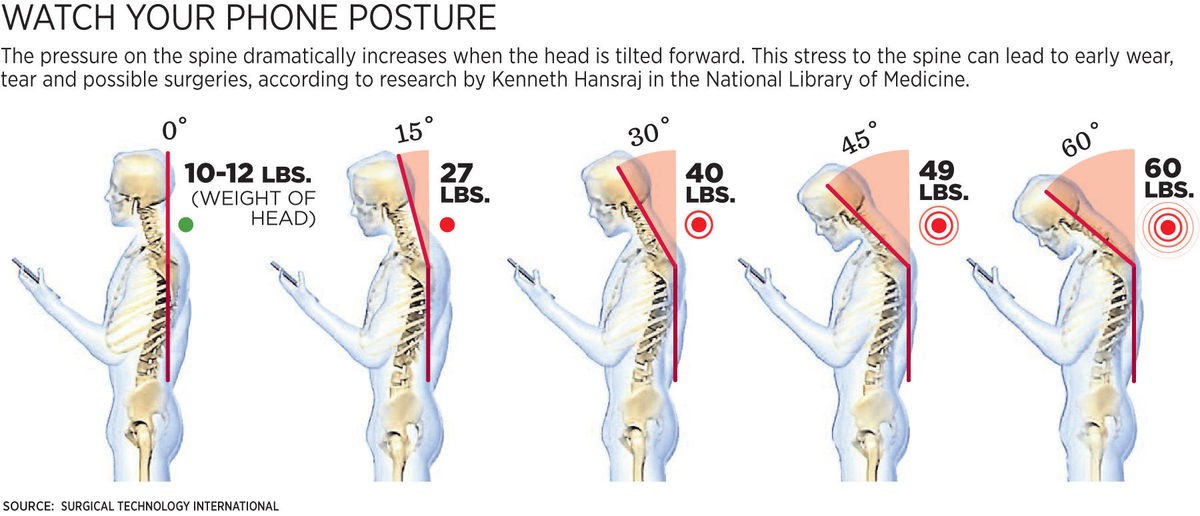Text-Neck Tips and Tricks with Dr. Gloria Cheung
Do you find yourself with neck pain after looking at your phone, tablet or laptop for too long?
If you suffer from neck pain or headaches, you might have text-neck!

Between keeping up with messages from friends and family, work, news, emails and for leisure – the average person spends 5 hours every day looking at their mobile device! And unfortunately, all that time looking down at your device has consequences for your neck.
“Text-neck” is a term used to describe neck pain, back pain, and maybe even headaches or migraines that people experience as a result of frequently looking down at your mobile device, whether that be a cellphone, tablet or computer.
How do you get text-neck?
The human head weighs approximately 10-12 pounds. When the head bends forward to look down at your mobile device, the weight that is put on your neck (aka cervical spine) increases. Even with a small, 5 degree forward tilt, your neck has to support nearly 30 pounds! The more you crane your neck, the more weight it has to carry, as the image below shows.

What are the symptoms associated with text-neck?
If you have text-neck, you may feel one of, or a combination of the following:
- Neck and upper back pain ranging from a dull, stiff pain to sharp muscle spasms that are typically worse at the end of the day,
- Headaches in your temples, forehead or behind the eye,
- Shoulder pain and stiffness,
- Numbness and tingling down your arms.
Check-in with how your body feels during or after using your mobile device. The quicker you can take steps to reduce the symptoms, the better your overall health and wellbeing can be!
So, what can I do?
It’s important to practice good posture and habits when you are on your mobile device, in order to prevent and minimize pain. Here are some tips that you can easily implement in your day-to-day life.
- Bring your screen to eye level. When you are on your phone, bring your arms up. When working at a desk for prolonged periods of time, stack books under your monitor screen, or invest in an ergonomic desk set up. I personally use a height-adjustable laptop stand along with a Bluetooth keyboard and mouse.
- Try your best to maintain a good posture. Sit or stand tall, like a ballet dancer. Look forward with your gaze aligned to the horizon rather than towards the floor when using your mobile device.
- Take frequent breaks from your screen. Set reminders on your phone every 20 minutes to get up, stretch and move around. Your neck and back will thank you!
- Arch your neck and upper back backward to look up at the ceiling periodically for a nice stretch.
- Share these tips with your friends, family, co-workers, and everyone else you see who may have text-neck!
Digital health and wellness is an important aspect of modern-day society and mobile devices are here to stay. We must continue to use them responsibly and with good habits so we can prevent any future aches and pains our bodies may feel. If you have any questions, would like to know more or if the pain continues to bother you, please consult your local healthcare professional.
Dr. Gloria Cheung, D.C, M.Sc
Registered Chiropractor
References
Cuéllar JM, Lanman TH. “Text neck”: an epidemic of the modern era of cell phones? The Spine Journal. 2017Jun;17(6):901–2.
Hansraj KK. Assessment of stresses in the cervical spine caused by posture and position of the head. Surgical Technology International. 2014Nov;25:277–9.
Meziat-Filho N, Ferreira AS, Nogueira LAC, Reis FJJ. “Text-neck”: an epidemic of the modern era of cell phones? The Spine Journal. 2018Apr;18(4):714–5.
Reid S, Portelli A. The effects of ‘text neck’ on head repositioning accuracy: a two group comparative study. Physiotherapy. 2015May4;101(1):e1270.

